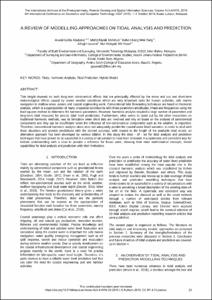| dc.contributor.author | Abubakar, Auwal Garba | |
| dc.contributor.author | Mahmud, Mohd Razali | |
| dc.contributor.author | Tang, Kelvin Kang Wee | |
| dc.contributor.author | Hussaini, Alhaji | |
| dc.contributor.author | Md Yusuf, Nur Hidayah | |
| dc.date.accessioned | 2021-12-14T22:17:04Z | |
| dc.date.available | 2021-12-14T22:17:04Z | |
| dc.date.issued | 2019 | |
| dc.identifier.citation | Abubakar, A. G., Mahmud, M. R., Tang, K. K. W., Hussaini, A. and Md Yusuf, N. H. (2019) A Review of modelling approaches on tidal analysis and prediction. International Archives of the Photogrammetry, Remote Sensing and Spatial Information Sciences, XLII-4/W16, pp. 23–34. DOI: https://doi.org/10.5194/isprs-archives-XLII-4-W16-23-2019 | en_US |
| dc.identifier.uri | https://repository.oceanbestpractices.org/handle/11329/1806 | |
| dc.description.abstract | Tide height depends on both long-term astronomical effects that are principally affected by the moon and sun and short-term meteorological effects caused by severe weather conditions which are very important tasks for human activities, safe marine navigation in shallow areas, oceans and coastal engineering work. Conventional tidal forecasting techniques are based on harmonic analysis, which is a superposition of many sinusoidal constituents with three parameters amplitudes, Phase and frequencies using the least squares method to determine the harmonic parameters. However, harmonic analysis required a large number of parameters and long-term tidal measured for precise tidal level predictions. Furthermore, what seems to stand out by the other researchers on traditional harmonic methods, was its limitation when short data are involved and rely on based on the analysis of astronomical components and they can be insufficient when the influence of non-astronomical components such as the weather, is important. Therefore, conventional harmonic analysis alone does not adequately predict the coastal water level variation, in order to deal with these situations and provide predictions with the desired accuracy, with respect to the length of the available tidal record, an alternative approach has been developed by various tidalist. In this study the state - of - art for tidal analysis and prediction techniques that have proven to be successful in a variety of circumstances have been reviewed in a systematic and consistent way for holistic understanding with a view to provide a reference for future work, showing their main mathematical concepts, model capabilities for tidal analysis and prediction with their limitations. | en_US |
| dc.language.iso | en | en_US |
| dc.rights | Attribution 4.0 International | * |
| dc.rights.uri | http://creativecommons.org/licenses/by/4.0/ | * |
| dc.subject.other | Tidal analysis | en_US |
| dc.subject.other | Tidal prediction | en_US |
| dc.subject.other | Harmonic analysis | en_US |
| dc.subject.other | Forecasting techniques | en_US |
| dc.title | A Review of modelling approaches on tidal analysis and prediction. | en_US |
| dc.type | Journal Contribution | en_US |
| dc.description.refereed | Refereed | en_US |
| dc.format.pagerange | pp.23-34 | en_US |
| dc.identifier.doi | https://doi.org/10.5194/isprs-archives-XLII-4-W16-23-2019 | |
| dc.subject.parameterDiscipline | Other physical oceanographic measurements | en_US |
| dc.bibliographicCitation.title | International Archives of the Photogrammetry, Remote Sensing and Spatial Information Sciences | en_US |
| dc.bibliographicCitation.volume | XLII-4/W16 | en_US |
| dc.description.sdg | 14.a | en_US |
| dc.description.eov | Sea surface height | en_US |
| dc.description.methodologyType | Reports with methodological relevance | en_US |
| obps.contact.contactemail | gaauwal2@live.utm.my | |
| obps.resourceurl.publisher | https://www.int-arch-photogramm-remote-sens-spatial-inf-sci.net/XLII-4-W16/23/2019/ | |
 Repository of community practices in Ocean Research, Applications and Data/Information Management
Repository of community practices in Ocean Research, Applications and Data/Information Management

